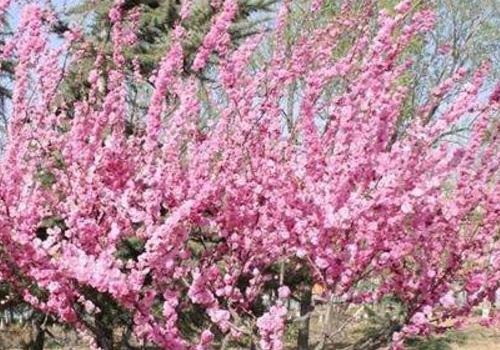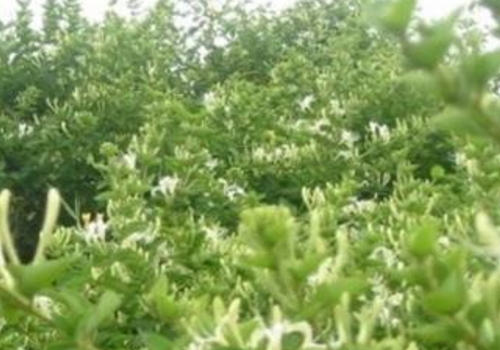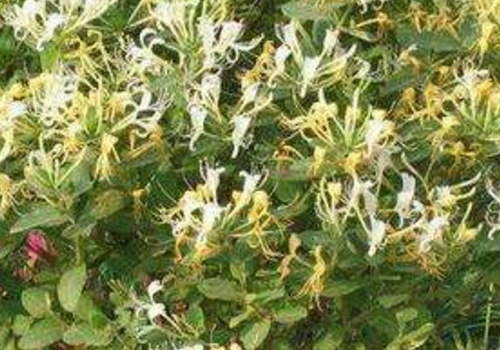The difference between the grafting of Prunus mandshurica and Peach
Trifolium plum is very good-looking, many people think it is a peach. How does the plum blossom graft? The difference between peach and peach?
How do I get a seed?:
1. Method and time of grafting of trifoliate plum
There are two grafting methods of Prunus triloba, bud grafting and branch grafting. Generally, bud grafting is selected more.
Bud grafting is best done in mid-to-late August, and grafting should be done in February to March in spring.
2. Material selection of bud grafting of Prunus triloba
Budding rootstock available annual seedlings of flowering plum, or with wild rose plants, peach, peach seedlings can be.
Bud can be selected from excellent varieties, strong growth, no pests and diseases on the plum tree, choose to cut the full leaf bud on the annual branch for standby.
3. Selection of materials for branch grafting of Prunus triloba
The scion of branch grafting should be cut off before the plant sprouts, and the scion of winter toughness can also be cut off and stored in sand for use in spring.
4. Notes on grafting of trifoliate plum
If you want to graft into small arbor-like culture, can be in the apricot and other rootstocks on the trunk of high grafting, so that the position of the crown increased.
After budding in autumn and August, do not let it germinate in the same year, cut the rootstock from the top 2~3cm of the budding in the next spring, and let the budding germinate into branches.
Branches are generally cut or split, in early spring in late March when the winter buds begin to expand, after planting soil or with a material bag will scion together with the interface sleeve, about 20 days can survive.
After survival, the tillers on the rootstock should be removed in time, and the plastic bag or soil can be gradually removed as the temperature rises.

The difference between plum and peach:
1. Different families
Prunus triloba is a plant belonging to the peach genus of Rosaceae, while peach is a plant belonging to the plum genus of Rosaceae.
Prunus triloba has been cultivated for hundreds of years in China and is cultivated in most parks throughout the country. This species blooms early, mainly for ornamental, common cultivation types are double leaf trifoliate plum, also known as small peach, because its leaves like elm leaves, flowers like plum named.
Green peach, also known as Chiba peach blossom, is a variety of peach blossom, belonging to the ornamental peach blossom semi-double and double petal varieties, collectively referred to as green peach, common varieties have red flower green leaf green peach, red flower red leaf green peach, white red two-color gold peach and other varieties. Peach has high ornamental value, in the community, parks, streets everywhere beautiful plants.
2. Different branches
The branches of Prunus triloba are brown and rough, the twigs of peach are reddish brown and glabrous, and the posture of the branches of peach is more vigorous than that of Prunus triloba.
3. The leaves are different
Trifolium leaves broadly elliptic to obovate, apex pointed or 3-lobed, base broadly cuneate, margin unequally heavily serrate.
The leaves are elliptic-lanceolate, 7-15 cm long, apex acuminate.
4. Flowers are different
The flowers of plum blossom are only pink, and there is no white, while the color of peach flower is richer, red, pink, purple and white, etc.
The flowering period of flowering plum is slightly earlier than that of peach blossom.
5. Different growth habits
Trimme is a temperate tree species, cold, drought resistant, like sunlight, soil requirements are not strict, but Trimme is not tolerant of waterlogging, like neutral to slightly alkaline soil.
Green peach also likes sunlight and drought tolerance, but green peach cold tolerance is not as good as plum. The growing soil should be fertile and loose, with good drainage.
Well, about the difference between plum and peach introduced here, I hope to help you.
Cultivation method of Prunus triloba-Prunus triloba| Photo Gallery| How do you raise elm leaves? elm leaves (Latin scientific name: Amygdalus triloba), also known as elm plum, small peach, elm leaf luan branch. Because of its leaves like elm, flowers such as plum, hence the name "elm leaf plum". And because of its variety of short branches and dense flowers, full of branches decorated with flowers, it is also known as "Luan branch." Prunus triloba is an important flowering shrub in spring gardens in northern china with dense branches and leaves and colorful flowers. It has strong saline-alkali resistance and should be widely used in Beijing gardens to reflect the thriving scene of bright spring and colorful flowers. Culture method of flowering plum
1. Soil: The requirements for soil are not strict, but they are not resistant to waterlogging. They like neutral to slightly alkaline, fertile and loose sandy loam.
2, watering: avoid waterlogging, spring planting, if the weather is dry, to water 2-3 times, usually do not water, at the same time pay attention to rainy season drainage.
3, sunshine: in autumn, winter, spring three seasons can be given sufficient sunlight, placed indoors maintenance, try to put in bright light places, such as good lighting living room, bedroom, study and other places.
The method of propagation of Prunus triloba
1. Grafting propagation of Prunus triloba
Grafting methods are bud grafting and branch grafting two kinds, generally with bud grafting more. Bud grafting should be carried out in the middle and late August. Rootstock available annual seedlings of plum trifoliate, or with wild rose plants, peach, peach seedlings can be. Bud grafting can be selected from the excellent varieties of flowering plum plants, cut on the annual branches of the full leaf bud reserve. Branching should be done in February-March in spring. Scions should be cut before the plants sprout. The scion can also be cut off in winter and stored in sand for use in spring.
When does the flower bloom?
Prunus triloba is named for its leaves similar to elm leaves. It is a kind of early spring flower species widely cultivated in northern China. Deciduous shrubs, 3-5m tall, branchlets fine, glabrous or slightly pilose when young. Leaves elliptic to obovate. The hemispherical plants are all covered with colorful flowers, which are very beautiful and spectacular. The variety of Prunus triloba is very rich. According to investigation, Beijing has more than 40 varieties, and there are more than 100 petals, and there are long stems and other types. Flowering in April; fruiting in August.
Flower language of Prunus triloba
Plum flower language: spring bright, flowers and thriving, there is the intersection of the soul.
Price of plum blossom
Prunus triloba has the advantages of cheap price, good greening effect, high survival rate of transplanting, easy organization of goods, simple planting and low maintenance cost. At present, the price of 180cm height of Prunus triloba on the market is 35-90 yuan/tree.
Grafting of Prunus triloba
1. Splitting method: Cut the stem at 5 cm from the ground, cut off the small lateral branches and useless branches around the root, cut the saw flat, then cut vertically at 1/3 of the cross section of the rootstock with a cutter, the depth should be slightly less than the large cut surface of the scion, cut the scion short into 3~5 scion full buds, cut the lower end into 3 cm large cut surface, the cut surface must be flat, quickly cut the scion inward according to the large oblique surface, align the cambium of the rootstock and scion, and then wrap it tightly with thin film. And the most apical bud is kept outside the film to improve the survival rate.
The difference between plum and peach
Peaches: deciduous small trees, up to 8 m tall, usually 3-4 m after shaping, branchlets reddish brown, glabrous; leaves elliptic-lanceolate, 7-15 cm long, apex acuminate. Flowers solitary or two in leaf axils, double petalous, pink. Other varieties are white, crimson, gold (variegated) and so on.
A deciduous shrub or small tree. Branches brown, rough. Leaves broadly elliptic to obovate, apex pointed or 3-lobed, base broadly cuneate, margin unequally heavily serrate. Flowers pink, often 1 - 2 born in leaf axils. Flowering April. Drupe red, subglobose, hairy.
In fact, according to the leaf shape, it can be concluded that the elliptic-lanceolate is the peach; the broad elliptical to obovate, and the leaf edge is serrated (very like elm leaves) is the plum.
Related encyclopedias
Pocket scale non-woven bag lamp grass bamboo shoots crab feet red rice note3ykk zipper ybs zipper mountain cherry climbing wall plum wild cassia winter plum pine watch Omega Longines famous watch children's building blocks flint azalea orchid roll stick thorn fruit Annona
The key to survival of grafting propagation
Grafting method is to plant the flower plant branches or buds artificial grafting in another flower plant stem or root, grafted part called scion, grafted flower plant called rootstock. Grafting is divided into two categories: branch grafting and bud grafting. This method can not only maintain the characteristics of the original varieties, overcome the difficulties of difficult reproduction by other methods, but also improve the resistance to adverse environmental conditions, promote or inhibit the growth of flowers and trees, and early flowering. This method is mostly used for woody flowers, and a few herbaceous flowers can also be grafted.
(1)Affinity: The key to survival of grafting depends on the affinity between scion and rootstock. The ability of scion and rootstock to heal after grafting. It depends on the kinship between the two. Generally speaking, the rootstock and scion have little difference in physiology, morphology, structure and heredity. Therefore, grafting generally choose the same family or the same family close to the same species of flowers, grafting easy to heal. On the contrary, it is difficult to survive after grafting. Such as rose grafting in rose, because both belong to rose family rose genus, grafting survival rate is higher. Ligustrum lucidum grafted osmanthus, they belong to oleaceae, Ligustrum lucidum for Ligustrum, osmanthus for Osmanthus, is the same family of flowers, although there are certain differences between them, but there is a certain affinity, after grafting can survive. For example, rose peach, apricot rootstock grafting plum blossom, peach, trifoliate plum; seeding begonia seedlings grafting Xifu begonia, plumule begonia, etc., are feasible. If rose grafting on willow is not viable, because there is no trace of kinship between the two, there is no affinity, can not produce healing tissue.
(2)Grafting time: In addition to depending on whether the rootstock and scion have affinity, the time and method of grafting are also crucial. The closer the sap flow period and germination period of scion and rootstock are, the higher the survival rate after grafting. If the scion has begun to germinate and the rootstock is still dormant, the scion will soon die without a supply of ice and nutrients from the rootstock. In northern China, it is generally carried out in March and April in spring. Bud grafting takes place in June and August in summer. Sprouts are taken from fully mature buds on new shoots of the current year. If the collection is too early, the bud is not mature enough, or the collection is too late, it will cause no peeling, which will affect the grafting survival rate.
- Prev

When does the flower bloom and reproduce?
Honeysuckle, I believe many people have seen, is more common. When does honeysuckle flower? How to reproduce? When does honeysuckle bloom: honeysuckle generally begins to bloom in late May and ends in mid-October. The flowering period is about 150 days. Usually, the first crop flowers in late May and the second crop flowers in mid-late July.
- Next

How to water honeysuckle? why don't they blossom?
Honeysuckle, many people are growing, but do not blossom. How to water honeysuckle? Why not blossom? How to water honeysuckle: the principle of watering honeysuckle is: see dry and wet, keep the soil moisture at 30%. 1. Spring and summer: the temperature returns in spring, which is the peak growing season of honeysuckle, if there is enough water.
Related
- Fuxing push coffee new agricultural production and marketing class: lack of small-scale processing plants
- Jujube rice field leisure farm deep ploughing Yilan for five years to create a space for organic food and play
- Nongyu Farm-A trial of organic papaya for brave women with advanced technology
- Four points for attention in the prevention and control of diseases and insect pests of edible fungi
- How to add nutrient solution to Edible Fungi
- Is there any good way to control edible fungus mites?
- Open Inoculation Technology of Edible Fungi
- Is there any clever way to use fertilizer for edible fungus in winter?
- What agents are used to kill the pathogens of edible fungi in the mushroom shed?
- Rapid drying of Edible Fungi

